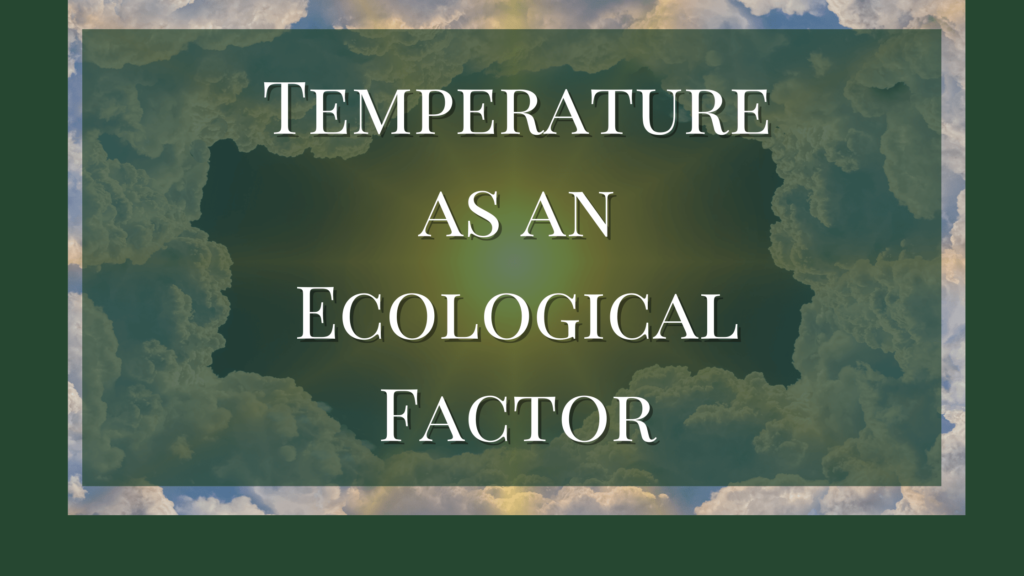Temperature as an ecological factor is essential for all life activities of plants such as germination, growth, reproduction, etc. All these activities are influenced by temperature in one way or the other. At the same time. not every area on the earth has the same temperature. it varies depending on various factors such as latitude and altitude.
Effect of temperature as an ecological factor
The metabolic processes begin at a certain temperature called minimum temperature. The anabolic activities increase due to the rise in temperature and reach the maximum efficiency at a temperature called optimum temperature.
If the temperature is increased further, the metabolic processes slacken gradually and stop at a temperature called maximum temperature. Hence below the minimum and over the maximum temperature, there are no activities in the plants.
Plants have no fixed internal temperature and hence their temperature varies according to their environmental conditions. The plants growing in tropical temperate and arctic regions are characterized by the repetitive reduction of temperature of their plant body.
Though plants can withstand a wide range of temperatures, they usually adapt themselves to a particular temperature so that the habit of the plant becomes restricted to a definite range of temperature.
Temperature as an ecological factor can be a variable influenced by time, season, altitude, snow, direction, soil texture, plant cover, etc. It penetrates heavy regions of the biosphere and profoundly influences all forms of life by exerting its action through increasing and decreasing some of the vital activities, metabolism, behavior, reproduction, embryonic development, and growth.
Thermal Energy Exchange
Temperature as an ecological factor is transferred from one organism to another in the form of heat energy. Temperature is a measure of the intensity of heat. In terms of standard units, it is commonly expressed as a degree unit, Fahrenheit or Celsius. Heat is a form of energy called thermal energy.
Thermal energy is exchanged between animals and the environment by radiation, conduction, convection, and evaporation. These four basic modes of energy transfer occur within the organism and in the interface between the organism and its environment.
The total amount of heat entering the biosphere from the sun is balanced by the amount lost per unit of time. The flow of geothermal heat from the interior of the earth is small compared to the amount of heat entering the biosphere from the sun. The estimate of thermal energy flow in the biosphere is known as the heat budget.
Effect of Temperature on Plants
As mentioned earlier, temperature affects the rate of metabolic activities of plants. It influences photosynthesis, respiration, transpiration, flowering, and germination. For eg., an increase in temperature increases the rate of photosynthesis and transpiration.
- Cardinal temperatures differ for the different functions of the same plant. The rate of photosynthesis and respiration increases with an increase in temperature.
- The temperature control of the photosynthesis-respiration relationship plays an important role in the food reserves of plants, particularly of underground storage types and fruiting ones.
- High temperature during the day increases the rate of photosynthesis and the low temperature during night reduces the rate of respiration considerably so that the photosynthetic products are conserved and stored.
- High temperature decreases the relative humidity of the atmosphere. This will lead to an increase in the rate of transpiration. Conversely, a decrease in temperature increases relative humidity and reduces the transpiration rate.
- Temperature affects the ratio of cuticular to stomatal transpiration. High temperature increases the rate of cuticular transpiration, even if the stomata are closed. This happens particularly at night.
Depending on the conditions of temperature, plants are classified as
- Megatherms where the prevailing temperature is high throughout the year. The major vegetation here is the tropical rainforest.
- Mesotherms are plants growing in areas where the temperature fluctuates between high and low levels in a year. Eg. Tropical deciduous forest.
- Microtherms are the vegetation growing in low prevailing temperatures. Confers are the perfect examples here.
- Hekisotherms are the alpine vegetation growing in extremely low temperatures.
Conclusion
In conclusion, temperature as an ecological factor remains crucial. It can influence the organism’s distribution, behavior, and survival within ecosystems. It emphasizes, various interactions between the organism and the environment and helps shape their adaptations to it.
References
- Shukla, R.S. and Chandel, P.S. (2001) Plant Ecology. S. Chand and Company Ltd., New Delhi.
- Verma, P.S., Agarwal, V.K. (1999). Cell Biology Genetics Molecular Biology Evolution and Ecology. New Delhi: S.Chand Co.(Pvt) Ltd.
Additional Reading
- Climatic Factors: Atmospheric Moisture
- Light as an Ecological Factor
- Edaphic Factors or Soil Factors




